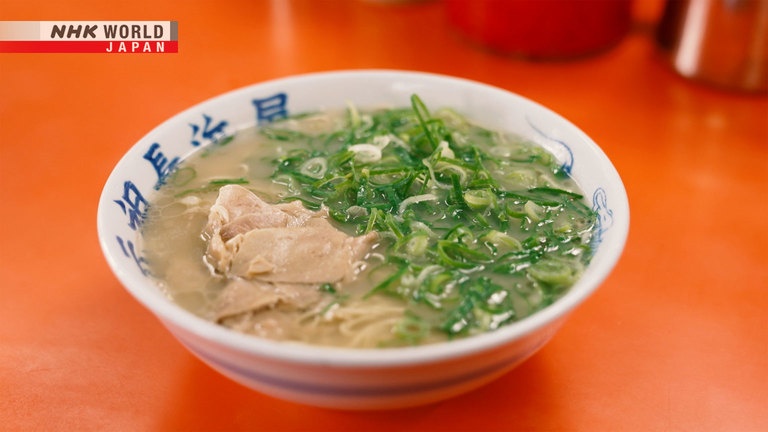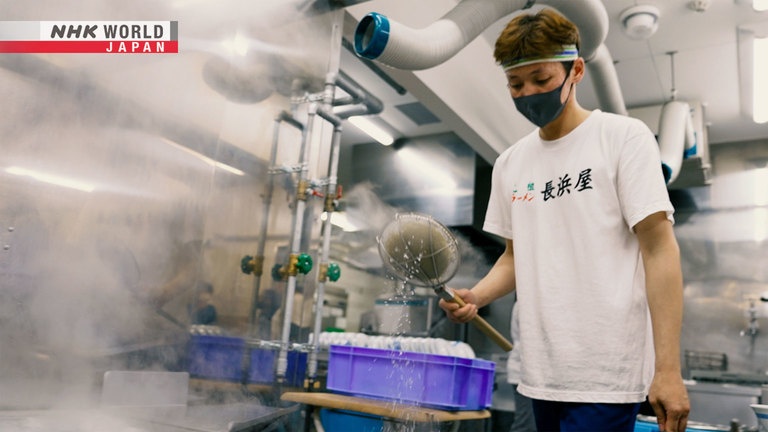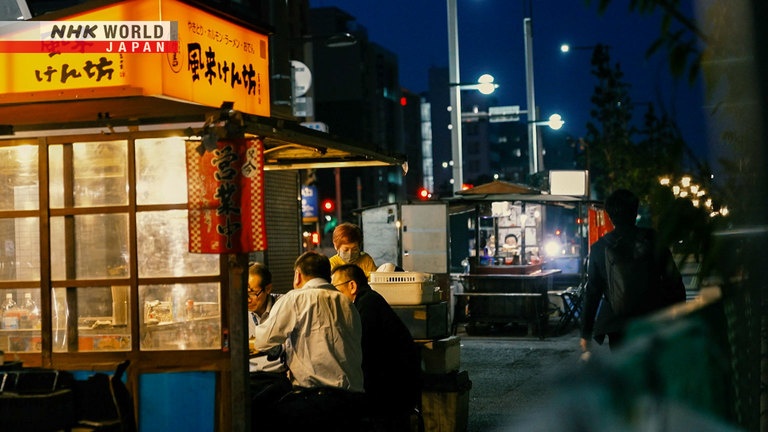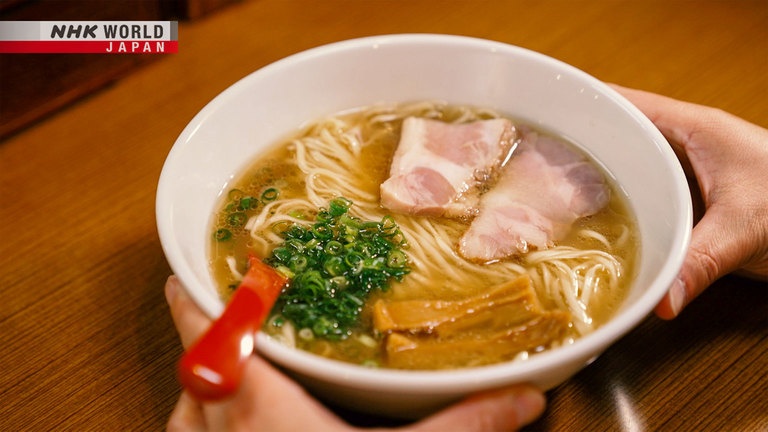TONKOTSU RAMEN: FUKUOKA Part 1
A gourmet tour of ramen all around Japan. This time: the birthplace of tonkotsu, Fukuoka Prefecture. Looking at the Hakata and Nagahama styles, we'll learn these ramens' secrets, and the story of its creation.




Transcript
Ramen...
A Japanese staple that's now popular worldwide.
Each region has its own vision, shifting with the times while staying true to the original.
"Irasshaimase!"
Welcome to Japan, the land of ramen!
For our first episode, "tonkotsu" ramen.
And for tonkotsu, Fukuoka is the place.
There are three distinct styles:
Kurume, Hakata, and Nagahama.
And over the next two episodes, we'll explore the differences in detail.
Nagahama is home to a market that supports the kitchens of Fukuoka with fresh fish.
About 3,700 people work here.
And to keep their bellies full, nothing beats tonkotsu ramen.
Nagahama, near the center of Fukuoka City, looks out on the fishing port.
The small neighborhood only has around 3,000 residents.
And it's also the namesake of Nagahama style tonkotsu ramen.
Let's find out what makes it so delicious.
The ingredients are pork bones
("tonkotsu"), back fat, skin, and garlic.
That's all. It's very simple.
From open to close, it's cooked
all day with the burner on full.
Cooked at high heat all day, the broth is made with pork bones.
But at this stage, it's unseasoned.
The final taste comes from this special soy sauce.
Nagahama style uses thinner noodles.
A single serving is 110g.
Ordinary noodles cook up quickly,
in about 1 minute.
Green onions and "chashu" pork are
the only toppings it comes with.
You can add sesame seeds or
pickled ginger as you like.
And adding mustard greens
has a big impact on the flavor.
The smell of "tonkotsu"! Delicious!
Nagahama style ramen first appeared in 1955, after the fish market came to the area.
Ramen stands were built to provide breakfast for the workers in the market.
Nagahama ramen is special.
Kurume ramen, for example,
comes from Kurume City.
But Nagahama is just one neighborhood.
It may be the only style of ramen
associated with just one area.
So says Hara Tatsuo, who's been eating Nagahama ramen since his teens.
They come in for ramen after
the auctions in the fish market.
There's a big rush, and you
have to get the ramen out fast.
That's why the noodles are thinner,
so you can serve them more quickly.
The first ever ramen stall in Nagahama has changed shape, and is now in this building.
The auction ends at 4:30 AM, and now they're open for business.
Tonkotsu ramen is the only thing on the menu.
As soon as they open, the customers are waiting.
Step inside and...
"Kata" = firm noodles
Customers choose the doneness of their noodles.
This is Nagahama style!
The firmest doneness is "nama."
"Kata" is a little bit more done.
Then there's "futsu," normal,
and "yawa," or tender.
The woman speaking with this husky voice is Yamamoto Kazuko, the 3rd-generation owner, born in 1950.
I don't want to be on camera!
I can hardly stand using a mirror.
In the beginning, over 55 years ago,
we didn't offer firm or tender noodles.
But sometimes a customer at the stall
would say, "I'm not feeling well today."
So, we'd make them a little more tender.
That's how it started.
There's another essential for Nagahama ramen.
"Kaedama," very firm please!
A second helping of noodles, or "kaedama," a custom that began right here in this shop.
Hara relates the origin story of kaedama.
In 1955, a man called Inoue Hisato
was working in the area.
After work, he loved to take his family
out for Nagahama ramen.
Kids have a healthy appetite,
and so they'd want seconds.
He didn't have the money, so he asked
for just a second helping of noodles.
That's how the custom started.
We just did what customers wanted
and that inevitably become the norm.
We have lots of regular customers,
many of them come in 5 days a week.
"Do you come in often?"
Yeah, About 5 days a week.
This man's a truck driver.
The ramen he gets is a bit different.
"There are no green onions."
I never get them. Onions change the flavor.
We always give regulars their usual.
His first helping is extra tender noodles,
and for the "kaedama" he gets firm.
It's all up here in my head.
He has everyone's orders memorized.
It's really good as usual.
I drove long-haul yesterday,
so I'm pretty tired.
Nagahama ramen helps me recover.
Nagahama ramen keeps hardworking people, locals, and everyone else who tries it feeling full and satisfied.
A key supporting player for tonkotsu ramen:
spicy pickled "takana" mustard greens.
The mustard greens that are the main ingredient have long been grown in Miyama, southern Fukuoka.
They're a bit too sharp,
so generally they aren't eaten raw.
Pickling is the most common use.
Early April is the peak harvest season.
Picked by hand, the mustard greens are dried in the sun for half a day,
and then taken directly to the pickling facility.
These mustard greens were
pretty much born for pickling.
The mustard greens are pickled in wooden tubs that have been in use for over 80 years.
Turmeric and salt are added.
Mustard greens are actually very bitter,
so the pickling liquid gets quite murky.
Adding turmeric yields a tortoise-shell color
which is really rather beautiful.
After three months of fermentation, the process will be complete.
The resulting pickles are commonly used in local cooking.
To make them spicy, they add chili peppers.
Chopped and stir-fried in sesame oil.
For us, it's the taste of home.
Spicy mustard green pickles from southern Fukuoka.
A perfect pairing for tonkotsu ramen.
Hakata, central Fukuoka City.
Evening, and setup of the food carts begins.
In about an hour, they're open for business.
By 6 PM, over 100 of them are going full blast.
There's oden stew...
...yakitori...
...pub fare, and drinks.
There's also the style of ramen named for the local area.
Hakata ramen is known for its cloudy white soup.
But it seems it hasn't always been this way.
In the beginning, it wasn't so white and cloudy.
First appearing on the banks of this river around 1940,
its popularity spread in the blink of an eye.
That first Hakata ramen stall is still in business.
3rd-generation owner, Teshima Masahiko, made us a bowl of ramen with the original food stall recipe.
Naturally, pork bones form the base of the soup.
First we precook the bones.
Then we wash them and remove the marrow
before adding them to the broth.
We simmer the soup on the lowest heat,
so it doesn't emulsify or become cloudy.
The noodles aren't thin either.
We use broad, flat noodles.
This is the original Hakata tonkotsu ramen.
It's totally different from other styles.
The flat noodles are delicious.
It's not too greasy, light and tasty.
This ramen was the creation of Mori Kentaro.
It was his attempt to reproduce the chicken soup-based noodles he had eaten in Shanghai before the war.
He wanted to use chicken soup
just like they did in China,
but had no source of chicken bones.
At the time, a pork processer was
throwing out huge quantities of bones.
So, he used them instead of chicken.
Teshima's father, Takeomi, tried the ramen at Mori's stand.
That was the first time I ever ate ramen.
And it was delicious! Delicious!
I'd never had anything so delicious.
I had to open a ramen shop too.
At the age of 20, he became Mori's apprentice.
And a year later, he opened his own shop.
His son Masahiko took over at the age of 35.
Food goes in and out of fashion.
I think in terms of food culture,
it's important to make our ramen
the same way we've always made it
instead of following current trends.
I think consistency has meaning.
Hakata's history in a single bowl.
80 years later and there are 160 ramen shops in central Hakata alone.
Tonkotsu ramen: a Fukuoka original, the tastes developed in Hakata and Nagahama,
making it all the better.
Today, tonkotsu ramen is loved not only in Japan, but all over the world.
Wouldn't you like some yourself?
Come pay a visit for the best bowl of ramen you've ever had!